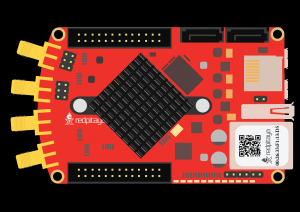2.3.6.3.7. Generate sweep signal
2.3.6.3.7.1. Description
This example shows how to program Red Pitaya to generate a sweep signal from 100 Hz to 100 kHz. Voltage and frequency ranges depend on the Red Pitaya model.
2.3.6.3.7.3. Required software
2.3.6.3.7.4. SCPI Code Examples
2.3.6.3.7.4.1. Code - MATLAB®
The code is written in MATLAB. In the code, we use SCPI commands and TCP client communication. Copy the code from below into the MATLAB editor, save the project, and hit the “Run” button.
%% Variables
waveform = 'sine';
ampl = 1;
% Sweep settings
sweep_start_freq = 100;
sweep_stop_freq = 100000;
sweep_time_us = 5000000; % in microseconds
sweep_mode = 'log'; % linear / log
sweep_dir = 'up_down'; % normal / up_down
%% Define Red Pitaya as TCP client object
IP = 'rp-f0a235.local'; % Input IP of your Red Pitaya...
port = 5000;
RP = tcpclient(IP, port);
%% Open connection with your Red Pitaya
RP.ByteOrder = "big-endian";
configureTerminator(RP, "CR/LF");
% Reset Generation
writeline(RP,'GEN:RST');
writeline(RP, append('SOUR1:FUNC ', upper(waveform)));
% Configure sweep settings
writeline(RP, append('SOUR1:SWeep:FREQ:START ', num2str(sweep_start_freq)));
writeline(RP, append('SOUR1:SWeep:FREQ:STOP ', num2str(sweep_stop_freq)));
writeline(RP, append('SOUR1:SWeep:TIME ', num2str(sweep_time_us)));
writeline(RP, append('SOUR1:SWeep:MODE ', upper(sweep_mode)));
writeline(RP, append('SOUR1:SWeep:DIR ', upper(sweep_dir)));
writeline(RP, 'SOUR1:SWeep:STATE ON');
writeline(RP, 'OUTPUT1:STATE ON');
writeline(RP, 'SOUR1:TRIG:INT');
%% Close connection with Red Pitaya
clear RP;
2.3.6.3.7.4.2. Code - Python
Using just SCPI commands:
#!/usr/bin/env python3
import redpitaya_scpi as scpi
channel = 1
waveform = 'sine'
ampl = 1
# Sweep settings
sweep_start_freq = 100
sweep_stop_freq = 100000
sweep_time_us = 5000000 # in microseconds
sweep_mode = "log" # linear / log
sweep_dir = "up_down" # normal / up_down
IP = 'rp-f0a235.local' # Connecting to Red Pitaya
rp = scpi.scpi(IP)
rp.tx_txt("GEN:RST")
rp.tx_txt(f"SOUR{channel}:FUNC {waveform.upper()}") # Specifying waveform
rp.tx_txt(f"SOUR{channel}:VOLT {ampl}") # Setting one-way amplitude
# Configuring Sweep settings
rp.tx_txt(f"SOUR{channel}:SWeep:FREQ:START {sweep_start_freq}") # Start frequency
rp.tx_txt(f"SOUR{channel}:SWeep:FREQ:STOP {sweep_stop_freq}") # Stop/End frequency
rp.tx_txt(f"SOUR{channel}:SWeep:TIME {sweep_time_us}") # Sweep time in us
rp.tx_txt(f"SOUR{channel}:SWeep:MODE {sweep_mode.upper()}") # Sweep mode
rp.tx_txt(f"SOUR{channel}:SWeep:DIR {sweep_dir.upper()}") # Direction
rp.tx_txt(f"SOUR{channel}:SWeep:STATE ON") # Turning ON sweep mode
rp.tx_txt(f"OUTPUT{channel}:STATE ON") # Enabling output channel
rp.tx_txt(f"SOUR{channel}:TRIG:INT") # Triggering the generator
rp.close()
Using functions:
#!/usr/bin/env python3
import redpitaya_scpi as scpi
channel = 1
waveform = 'sine'
ampl = 1
# Sweep settings
sweep_start_freq = 100
sweep_stop_freq = 100000
sweep_time_us = 5000000 # in microseconds
sweep_mode = "log" # linear / log
sweep_dir = "up_down" # normal / up_down
IP = 'rp-f0a235.local' # Connecting to Red Pitaya
rp = scpi.scpi(IP)
rp.tx_txt("GEN:RST")
# Set generator settings (waveform and amplitude, frequency does not matter)
rp.gen_set(channel, waveform, ampl, sweep_start_freq)
# Set sweep mode settings
rp.gen_sweep_set(channel, sweep_start_freq, sweep_stop_freq, sweep_time_us, sweep_mode, sweep_dir)
rp.tx_txt(f"SOUR{channel}:SWeep:STATE ON") # Turning ON sweep mode
rp.tx_txt(f"OUTPUT{channel}:STATE ON") # Enabling output channel
rp.tx_txt(f"SOUR{channel}:TRIG:INT") # Triggering the generator
rp.close()
Note
The Python functions are accessible with the latest version of the redpitaya_scpi.py document available on our GitHub. The functions represent a quality-of-life improvement as they combine the SCPI commands in an optimal order and also check for improper user inputs. The code should function at approximately the same speed without them.
For further information on functions please consult the redpitaya_scpi.py code.
2.3.6.3.7.5. API Code Examples
Note
The API code examples don’t require the use of the SCPI server. Instead, the code should be compiled and executed on the Red Pitaya itself (inside Linux OS). Instructions on how to compile the code and other useful information are here.
2.3.6.3.7.5.1. Code - C API
2.3.6.3.7.5.2. Code - Python API
